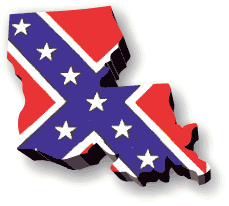

General Leroy Augustus Stafford
Pride of Rapides Parish,
Louisiana
Leroy Stafford, who had been sheriff of Rapides
Parish and was a veteran of the Mexican War, was a Cheneyville planter
who had talked peace with the North instead of war. During the tense period
before war finally broke out, Stafford heard there was talk in Alexandria
that he was against the war because he did not have the guts to fight.
The veteran bristled at such slander.
In such an atmosphere, he met one of his friends,
Dr. Smith Gordon, on an Alexandria street, and the two men went to a tavern
for drinks and a visit. What other subject could have been discussed but
secession and war? Finally, Stafford said to the doctor, " Smith,
these damned secessionists say we anti's won't fight; let's raise a company
for the war and show them we will".
So "Stafford's Guards" came into
being. In a matter of weeks, the company offered its services to Governor
Moore. They were accepted, and with a band playing martial music, flags
waving, and ladies weeping, "Stafford's Guards" left by steamer
on Red River, June 4, 1861, bound for the battlefields of Virginia.
The company went down the Red River, into the
Mississippi, and on to New Orleans. From there they were sent a short distance
away to Camp Moore in the pineywoods across Lake Pontchartrain in Tangipahoa
Parish. After a month's training, the unit was mustered into the Confederate
Army and designated as Company B of the Ninth Louisiana Regiment of Infantry.
Richard Taylor was colonel of the regiment. (Taylor later reassigned and
returned to Louisiana to play a major role in the 1863 and 1864 invasions
of Red River).
A month after leaving Alexandria, Stafford's
guards were part of a wildly cheering Ninth Louisiana headed for Richmond,
elated to at last be going where the action was. They reached Richmond
the day before the first Battle of Manassas (Bull Run) and were hurried
to that theater. But they were too late for action and were bitterly disappointed.
There was nothing to do but wait until spring at Centerville, Va., for
their chance at battle.
Stafford wrote back that measles, pneumonia,
dysentery, and typhoid fever swept the winter quarters with results
as disastrous as enemy bullets.
Stafford was promoted to colonel, and his brigade
placed in General Richard Ewell's division assigned to the Shenandoah Valley
to fight with Stonewall Jackson in defending that rich breadbasket of the
Confederacy. Colonel Stafford led his regiment in what is a roll call of
battles in Virginia--Winchester, Port Republic, Cold Harbor, Malvern Hill,
White Oak Swamp, Cedar Mountain, Fredericksburg, Second Manassas, and Chancellorsville.
Once the 41 year old Rapides Parish soldier
was captured after a hard march at double quick time when he had stopped
for breath. He was exchanged in time to lead his men through the hell of
Cemetery Ridge at Gettysburg, where they continued their march even in
the face of cannon and rifle fire sweeping their lines from the hill top.
They reached the heights, and those who survived crossed Union lines. That
was July 4, 1863.
In October, Stafford was promoted to Brigadier
General.
In May, 1864, General Stafford was fatally
wounded during the Battle of the Wilderness. During the fury of the battle,
a courier rushed up to inform the general that the enemy was on his flank.
Stafford checked the situation himself, then ordered a change of position.
He was waiting for the last man in the brigade to ride off in the changed
direction when a bullet severed his spinal cord.
Messages were sent to the Secretary of War
daily on the condition of General Stafford by General Robert E. Lee. Stafford,
42, died in Spottswood Hotel in Richmond, leaving a wife and nine children.
His body lay in state in Richmond at the home of Senator Thomas J. Semmes
of the Confederate Cabinet, and he was buried with military honors in Richmond,
in Hollywood Cemetery. President Jefferson Davis attended the funeral.
His remains were moved in 1886 to "Greenwood"
in Rapides Parish, Louisiana, his ancestral home, and where they remain
to this day.